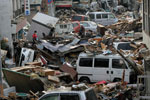

According to IHS iSuppli, the earthquake that hit Japan on 11 March has resulted in the suspension of one quarter of the global production of silicon wafers used to make semiconductors.
Manufacturing operations have stopped at Shin-Etsu Chemical’s Shirakawa facility. MEMC Electronic Materials also stopped manufacturing at its Utsunomiya plant. Together, these two facilities account for 25% of the global supply of silicon wafer used to make semiconductors. Wafers are thin slices of silicon that serve as the substrate of semiconductor devices. All semiconductors are built on wafers.
Shin-Etsu’s Shirakawa facility produces large 300 mm wafers, which are used in advanced semiconductors that have high transistor counts. The wafers made by this facility mainly are used in the manufacturing of memory devices, such as Flash memory and DRAM. Because of this, the global supply of memory semiconductors will be impacted the most severely of any segment of the chip industry by the production stoppage. Logic devices represent the next largest use of these wafers.
These companies supply not only domestic Japanese demand for wafers, but also semiconductor manufacturers around the world. Because of this, the suspension of operations at these plants could have wide-ranging implications beyond the Japanese electronics industry. A 25% reduction in supply could have a major effect on worldwide semiconductor production.
Shin-Etsu’s Shirakawa plant is responsible for 20% of global silicon semiconductor wafer supply. The plant is located in Nishigo Village, Fukushima Prefecture. Shin-Etsu reported that there has been damage to the plant’s production facilities and equipment. To compensate for the lost manufacturing, the company said it would set up production systems at other facilities. However, it warned that it was unclear how long it would take to restore the damaged facilities and equipment.
MEMC said it evacuated employees and suspended operations at its Utsunomiya plant after the earthquake. The Utsunomiya facility accounts for 5% of worldwide semiconductor wafer supply. MEMC said it expects that shipments from this facility will be delayed during the near term.
In another development for the global electronics supply chain, two Japanese companies announced they have stopped production of what amounts to 70% of the worldwide supply of the main raw material used to make printed circuit boards (PCBs). PCBs are used in all electronic products, from PCs to smartphones, to digital wristwatches. The companies, Mitsubishi Gas Chemical Company and Hitachi Kasei Polymer, said at the time of writing (21 March) that they would resume production of the raw material called copper-clad laminate (CCL) within two weeks.
However, with current inventory levels, IHS iSuppli believes that there likely is sufficient supply of finished PCBs and raw CCL material to keep electronics production lines running at global electronics manufacturers, as long as the interruption does not last significantly longer than two weeks.
Elpida Memory said its semiconductor assembly facility in Yamagata has been damaged. The company also said a lack of electricity is impacting production. The Yamagata facility’s utilisation rate now is at less than 50%.
The earthquake has damaged about 40% of the total wafer capacity of Renesas Electronics. The company has stopped production at its Tsugaru fabs producing analog and discrete devices, at its Naka facility making system-on-chip and microcontroller devices, and at its Takasaki and Kofu fabs making analog and discrete parts.
Half of the total wafer capacity at Fujitsu has been damaged. While the company’s fabs and wafer equipment are intact, the shortage of electricity, gas and wafers means it will take three or four weeks for the company to recover production.
Exacerbating the disruption to the supply chain, many electronic original equipment manufacturers (OEMs) worldwide could be engaging in panic buying of semiconductors and electronic components, spurred by fears of supply disruptions from Japan. Electronic distributors are reporting a surge in orders from OEM customers, trying to ensure they have sufficient inventory on hand to ride out any interruption in supply.
While the semiconductor supply disruptions are bad, they could have been worse; the recent build-up in global semiconductor inventory may serve to mitigate the impact of reduced supply from Japan. IHS iSuppli in February warned global semiconductor inventory levels had risen to alarmingly high levels, surging to a two-and-a-half year high in the fourth quarter of 2010. Although not completely compensating for supply disruptions from Japan, these excessive inventories may provide some cushion for global semiconductor supply.
Most component manufacturers have posted updates on their websites regarding how the earthquake has and will continue to affect their manufacturing capabilities, although they are understandably cagey, not wanting customers to panic. Readers who are concerned about supply issues relating to specific components or manufacturers are advised to visit the manufacturer’s website or contact the local distributor.
© Technews Publishing (Pty) Ltd | All Rights Reserved